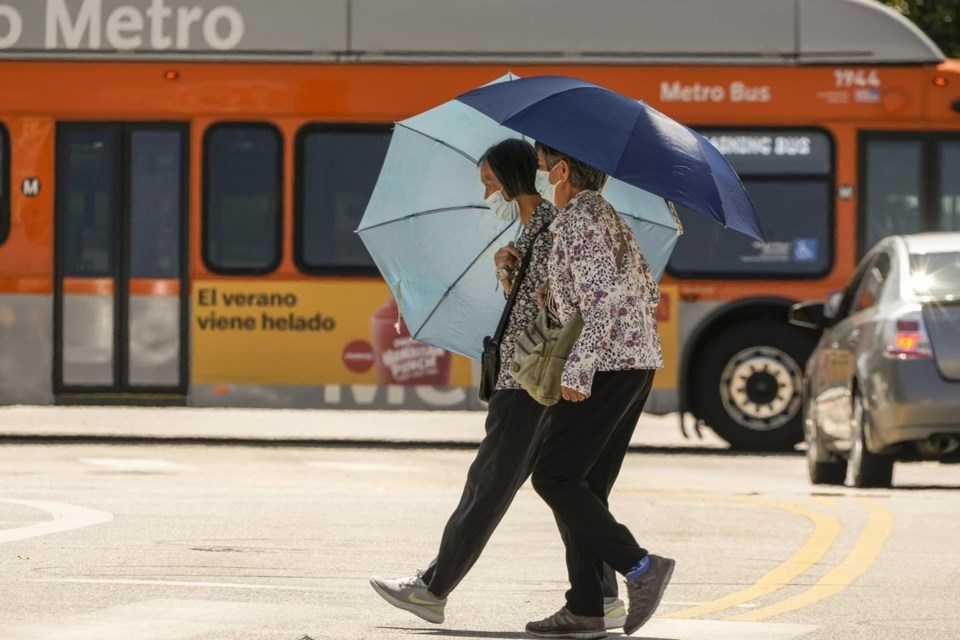PALM SPRINGS, Calif. (AP) — More than a third of Americans were under extreme heat advisories, watches and warnings Thursday as a blistering heat wave that's been baking the nation spread further into California, forcing residents to seek out air conditioning or find other ways to stay cool in triple-digit temperatures.
The sweltering conditions were expected to build Friday and through the weekend in Central and Southern California, where many residents should prepare for the hottest weather of the year, the National Weather Service warned. Highs in inland desert areas could top 120 degrees Fahrenheit (48.8 degrees Celsius) during the day, and remain in the 80s (above 26.6 C) overnight, offering little relief.
In the desert city of Palm Springs, many homeless people were left to contend with the heat on their own, with just 20 indoor beds at the lone overnight shelter.
John Summers, a homeless resident, climbed through a dry riverbed Thursday to seek shade at an encampment.
“I basically just use water as much as I can. And hit shade. And, you know, the mall, wherever they’ll let you in,” he said.
Roman Ruiz, the city’s homeless services coordinator, said homeless residents struggle daily just to find a place with enough shade.
“I don’t know how anyone can do it really,” he said. “I feel so bad, and yet there’s not much I can do.”
The mercury was expected to near 110 degrees (43.3 Celsius) in the city Thursday.
Elsewhere, officials prepared to repurpose public libraries, senior centers and police department lobbies as cooling centers, especially in desert areas.
The heat wave came as the California State Fair prepared to kick off Friday in Sacramento, forcing organizers to cancel planned horseracing events due to concerns for animal safety.
Forecasters said the long-duration heat wave is extremely dangerous, especially for older people, homeless residents and other vulnerable populations. The heat could persist into next week as a high pressure dome moves west from Texas.
In Las Vegas, regional health officials launched a new database Thursday to report “heat-caused” and “heat-related” deaths in the city and surrounding Clark County from April to October.
The Southern Nevada Health District said seven people have died since April 11, and a total of 152 deaths last year were determined to be heat-related. The tally includes deaths due to heat exposure or hyperthermia and cases with those reasons listed as “significant factors,” district spokesperson Jennifer Sizemore said.
Phoenix hit 110 degrees (43 Celsius) for the 14th consecutive day Thursday, putting it on track for a possible new record next week. The longest measured stretch of 110 degree-plus temperatures for the city is 18 days, recorded in 1974.
The overnight low temperature at Phoenix Sky Harbor International Airport Thursday morning was 95 degrees (35 C), which means temperatures may not be dropping far enough to allow people to recover after dark.
While there are some 200 cooling and hydration centers operated at libraries, community centers, churches and other public spaces across metro Phoenix, most close anywhere between 4 p.m. and 7 p.m., leaving people with few options for cooling off in the still-sweltering nights.
David Hondula, chief heat officer for the City of Phoenix, said some centers plan to close later over the weekend, including one downtown near a large encampment of homeless people that will stay open 24 hours.
Hondula suggested that the Federal Emergency Management Agency could play a role in the future to help keep cooling centers open longer.
“We’d certainly be interested to have that conversation," he said.
Meanwhile in California, cooling centers in and around Sacramento planned to offer some extended evening hours. In the small Central Valley city of Galt, about 25 miles (40 kilometers) south of the state capital, the police department planned to open its air-conditioned lobby between 2 p.m. and 10 p.m. from Friday until Monday.
“We want to make sure that anybody who does not have the ability to find appropriate shelter, that they can have a place to go to keep themselves in a safe and cool environment,” Lt. John Rocha said.
The same lobby served as a warming center during California’s unusually wet, cold and snowy winter, demonstrating the weather whiplash the state has experienced this year.
Employers were reminded to adhere to regulations that require outdoor workers are given water, shade and regular breaks to cool off. The state will be performing spot checks at work sites to make sure the rules are being followed, said Jeff Killip with California's Division of Occupational Safety & Health.
Meanwhile the wildfire season is ramping up amid the hot, dry conditions with a series of blazes erupting across the state this week, Wade Crowfoot, secretary of the Natural Resources Agency, said at a media briefing this week.
Global climate change is “supercharging” heat waves, Crowfoot added. California has instituted a $400 million extreme heat action plan to protect workers, help vulnerable communities and assist local communities in opening cooling centers.
People looking to cool down in California's many rivers should be wary, UCLA climate scientist Daniel Swain said, noting that waterways swollen from the epic Sierra Nevada snowpack remain dangerous as there is still snow left to melt.
“Be aware that the water will still be icy cold despite how hot the air will be and could be flowing very fast, much faster than usual for mid-July,” he said.
___
Har reported from San Francisco. Associated Press writers Anita Snow in Phoenix, Ken Miller in Oklahoma City, Ken Ritter in Las Vegas, John Antczak in Los Angeles and Julie Watson in San Diego contributed.
Eugene Garcia And Janie Har, The Associated Press



